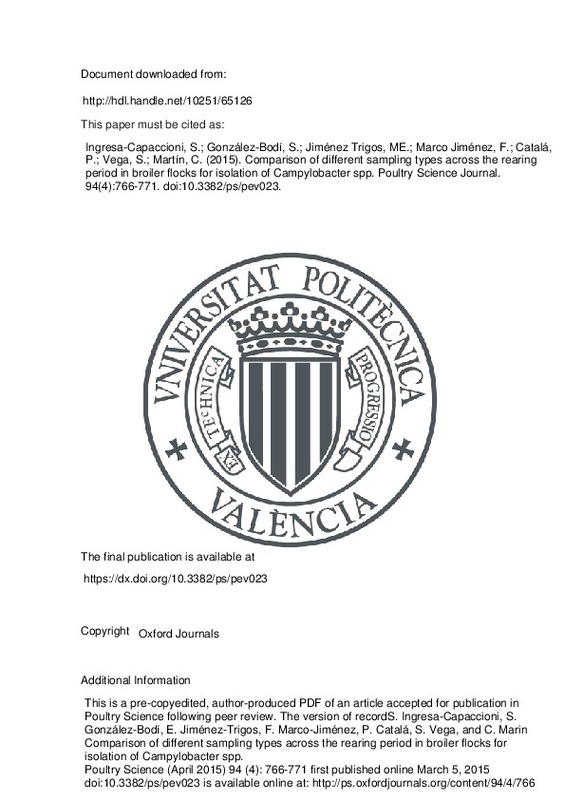JavaScript is disabled for your browser. Some features of this site may not work without it.
Buscar en RiuNet
Listar
Mi cuenta
Estadísticas
Ayuda RiuNet
Admin. UPV
Comparison of different sampling types across the rearing period in broiler flocks for isolation of Campylobacter spp
Mostrar el registro sencillo del ítem
Ficheros en el ítem
| dc.contributor.author | Ingresa-Capaccioni, Sofia
|
es_ES |
| dc.contributor.author | González-Bodí, S
|
es_ES |
| dc.contributor.author | Jiménez Trigos, María Estrella
|
es_ES |
| dc.contributor.author | Marco Jiménez, Francisco
|
es_ES |
| dc.contributor.author | Catalá, Pablo
|
es_ES |
| dc.contributor.author | Vega, Santiago
|
es_ES |
| dc.contributor.author | Marín, Clara
|
es_ES |
| dc.date.accessioned | 2016-06-02T12:51:13Z | |
| dc.date.available | 2016-06-02T12:51:13Z | |
| dc.date.issued | 2015-04 | |
| dc.identifier.issn | 0032-5791 | |
| dc.identifier.uri | http://hdl.handle.net/10251/65126 | |
| dc.description | This is a pre-copyedited, author-produced PDF of an article accepted for publication in Poultry Science following peer review. The version of recordS. Ingresa-Capaccioni, S. González-Bodí, E. Jiménez-Trigos, F. Marco-Jiménez, P. Catalá, S. Vega, and C. Marin Comparison of different sampling types across the rearing period in broiler flocks for isolation of Campylobacter spp. Poultry Science (April 2015) 94 (4): 766-771 first published online March 5, 2015 doi:10.3382/ps/pev023 is available online at: http://ps.oxfordjournals.org/content/94/4/766 | es_ES |
| dc.description.abstract | [EN] Campylobacter is the most common bacterial cause of human gastrointestinal disease in most developed countries. It is generally accepted that poultry products are a significant source of foodborne Campylobacter infections in humans. Assessing the effectiveness of any potential intervention at farm level requires monitoring of the Campylobacter status of broiler flocks, using appropriate sampling methods. The aim of this study was to assess the influence of the sample type across the rearing period for the detection of Campylobacter spp. at farm level. During this study, 21 commercial broiler farms were intensively sampled. Each farm was visited and sampled at different times during the rearing period (d 1, 7, 14, 21, 28, 35, and 42). On the first day of rearing, the status of the house and the day-old flock was evaluated, and environmental and cecal samples were collected. During rearing, 4 different sample types were collected: feces with sock swabs (sock swabs), feces directly from the litter (feces), cloacal swabs, and cecal content. All samples were analyzed according to ISO 10272-1:2006 (Annex E) and also by direct culture. The results of this study showed that Campylobacter spp. were detected in all of the sample types on d 14 of rearing. From this point on, the detection increased significantly, with a maximum detection rate by the end of rearing, regardless of the sample type. All samples that were negative upon direct culture were also negative after pre-enrichment. At the end of rearing, the percentage of samples positive for Campylobacter spp. was 71.4% for cecal samples, 61.9% for cloacal swabs, 45.2% for sock swabs, and 69.1% for fecal samples. C. jejuni was detected in all the sample types, with positive rates ranging from 67.1 to 76.0% for cecal samples and cloacal content, respectively. Cecal samples, cloacal swabs, and fecal samples cultured by direct plating onto modified charcoal cefoperazone deoxycholate agar (mCCDA) without pre-enrichment have the same sensitivity for detection of Campylobacter spp. in broiler flocks independent of the day of rearing. Guardar / Salir Siguiente > | es_ES |
| dc.description.sponsorship | We would like to thank the staff of the Valencian Poultry Association (ASAV) for funding this project, the Centre for Poultry Quality and Animal Feed of Valencia (CECAV) for offering us their facilities, and all his staff for their cooperation and dedication to this work. I would also like to thank the staff of the Department of Animal Science at the Polytechnic University of Valencia for their support of this study. | en_EN |
| dc.language | Inglés | es_ES |
| dc.publisher | Oxford Journals | es_ES |
| dc.relation.ispartof | Poultry Science Journal | es_ES |
| dc.rights | Reserva de todos los derechos | es_ES |
| dc.subject | Campylobacter | es_ES |
| dc.subject | Broiler | es_ES |
| dc.subject | Sample type | es_ES |
| dc.subject.classification | PRODUCCION ANIMAL | es_ES |
| dc.title | Comparison of different sampling types across the rearing period in broiler flocks for isolation of Campylobacter spp | es_ES |
| dc.type | Artículo | es_ES |
| dc.identifier.doi | 10.3382/ps/pev023 | |
| dc.rights.accessRights | Abierto | es_ES |
| dc.contributor.affiliation | Universitat Politècnica de València. Instituto de Ciencia y Tecnología Animal - Institut de Ciència i Tecnologia Animal | es_ES |
| dc.contributor.affiliation | Universitat Politècnica de València. Departamento de Ciencia Animal - Departament de Ciència Animal | es_ES |
| dc.description.bibliographicCitation | Ingresa-Capaccioni, S.; González-Bodí, S.; Jiménez Trigos, ME.; Marco Jiménez, F.; Catalá, P.; Vega, S.; Marín, C. (2015). Comparison of different sampling types across the rearing period in broiler flocks for isolation of Campylobacter spp. Poultry Science Journal. 94(4):766-771. doi:10.3382/ps/pev023 | es_ES |
| dc.description.accrualMethod | S | es_ES |
| dc.relation.publisherversion | https://dx.doi.org/10.3382/ps/pev023 | es_ES |
| dc.description.upvformatpinicio | 766 | es_ES |
| dc.description.upvformatpfin | 771 | es_ES |
| dc.type.version | info:eu-repo/semantics/publishedVersion | es_ES |
| dc.description.volume | 94 | es_ES |
| dc.description.issue | 4 | es_ES |
| dc.relation.senia | 292333 | es_ES |
| dc.identifier.eissn | 1525-3171 | |
| dc.contributor.funder | Universitat Politècnica de València | es_ES |
| dc.contributor.funder | Asociación Avícola Valenciana | es_ES |







![[Cerrado]](/themes/UPV/images/candado.png)

